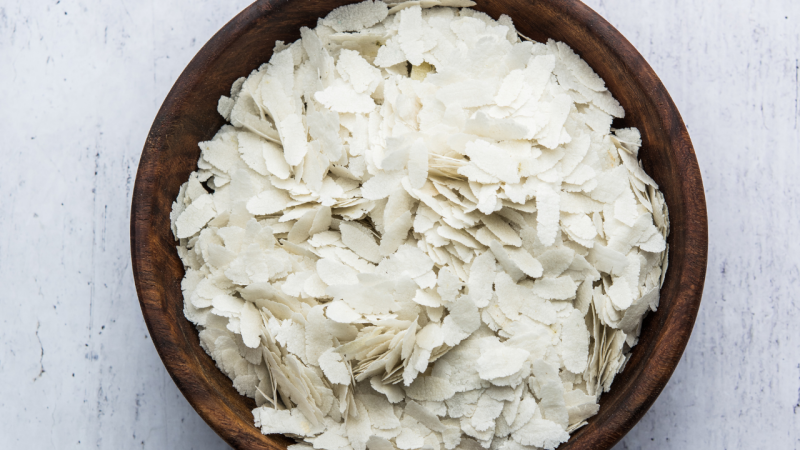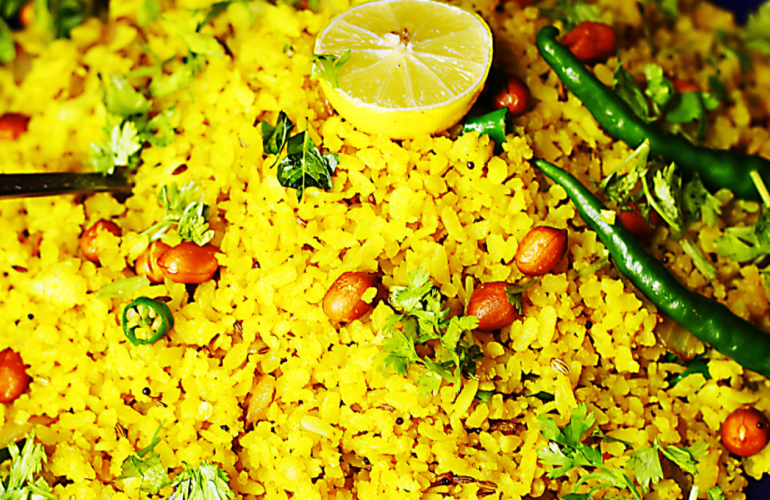Poha is also known as Beaten/ flattened rice or by many other names like Aval, Chiura, Chuda, Huda, and Avalakki in India.
Indians in different parts of the country cook it with multiple variations to make it more nutritious and healthy.
Poha or chivda has long been one of the favorite breakfast foods in many parts of India and is one of the most prominent weight loss foods used mostly as breakfast.
How is Poha Produced?
- Poha is made by partly cooking or parboiled paddy.
- Then, it is dryed out in the sun for few hours until it turns a bit harder.
- They are then pounded and flattened to give the form of ‘flat rice’ or Poha.
- It does not go through a lot of processing and is generally not polished.
White rice is polished to such an extent that its nutrients and fiber contents are stripped off.
Poha is less processed and light in terms of cooking and digestion.
Types of Poha
- White Poha: White poha comes with completely removed bran and it is a good source of carbohydrates. It is very easy to digest and is extremely rich in fiber and iron.
- Red Poha: Red poha is packed with antioxidants and is a great source of iron. It is red because of the presence of a pigment called anthocyanin. It has a nutty taste. It contains more fiber, vitamin B, and minerals like calcium, zinc, iron, manganese, magnesium, etc., as compared to white poha.
- Brown Poha: Brown poha is made from brown rice and is enriched with iron, potassium, and fiber.
Nutritional Information
Poha is rich in healthy carbohydrates, and is loaded with antioxidants and essential vitamins and minerals.
| Nutrients | 60 gm Uncooked Poha | 60 gm Cooked Poha |
| Calories | 210 Kcal | 300-350 Kcal |
| Carbohydrates | 39 gm | 52 gm |
| Protein | 4 gm | 8.5 gm |
| Fat | 3.9 gm | 7 gm |
Not only this, but Poha is also high in B complex Vitamins, vitamin A, vitamin C, iron, phosphorus, potassium, fiber, and calcium.
Keeping the basic cooking methods same, you can try many variations of Poha recipes by adding several vegetables of your choice to pack it with vitamins and minerals.
Health Benefits of including POHA in your diet
Poha provides multiple health benefits:
- It gives a perfect and energetic start to the day.
- It’s low on the glycemic index & high in fiber. Hence it may help in regulating blood sugar levels.
- Helps In Digestion : Poha is lighter for the stomach and gets digested easily. It does not cause bloating or gastric issues.
- Source of Iron : it is also beneficial for people at a higher risk of gestational anemia. A few lemon drops can be added to poha to increase the body’s iron absorption.
- Good for pregnant women & lactating mothers and even kids.
- It is an excellent breakfast option and a complete meal in itself.
- Probiotic : Poha is also a great probiotic. It is made by parboiling paddy and then drying it out in the sun. Then, it is beaten flat to make poha and it undergoes fermentation, which allows you to retain the microbial flora from the digested carbohydrates and protein by enhancing the gut health.
- Poha is a booster for your brain.
- They are lactose-free, heart-healthy, fat free, and also gluten-free.
- Good for Weight: It is easy to digest, high in fiber, enriched with probiotics, various variations to make, and a whole complete meal in itsef.
6 BONUS Reasons to have Poha in breakfast:

- Easy Availability.
- Poha is Economical hence pocket friendly.
- It is very easy to prepare in less time and efforts.
- It is a versatile ingredient.
- It is a local food, and is accessible, so you can avoid monotony in food ( by making different dishes from it).
- It can be consumed all around the year in all seasons.
How to cook Poha? & Recipes
Any recipe of poha has a pre-preparation step that requires Poha to rinse under water, and some people also soak it for 1-2 minutes.
Prominent Recipes:
- Vegetable Poha / Namkeen ( add peanuts and veggies ).
- Sweet Poha ( by adding ghee, jaggery and nuts).
- Poha with Curd : Add soaked poha, salt, ginger, and green chili paste to the curd. Mix all together and have it after setting it for five minutes.
- Poha in milk.
- Poha granola.
- Poha Namkeen snack.
Ayurvedic properties
Nature : Dry & Easy to heavy to Digest
Potency : Cooling
Taste : Sweet
Dosha : Pacify Vaat & pitta may Aggravate Kapha
Side Effects
Poha has no discovered side effects till date and is completely safe to consume by anyone or evryone.
But, as I always say over/ wrong consumption of any food is not right and can lead to indigestion and upset stomach.
Wisely use the super healthy and nutritious ingredient “POHA” and attain maximum benefits.
